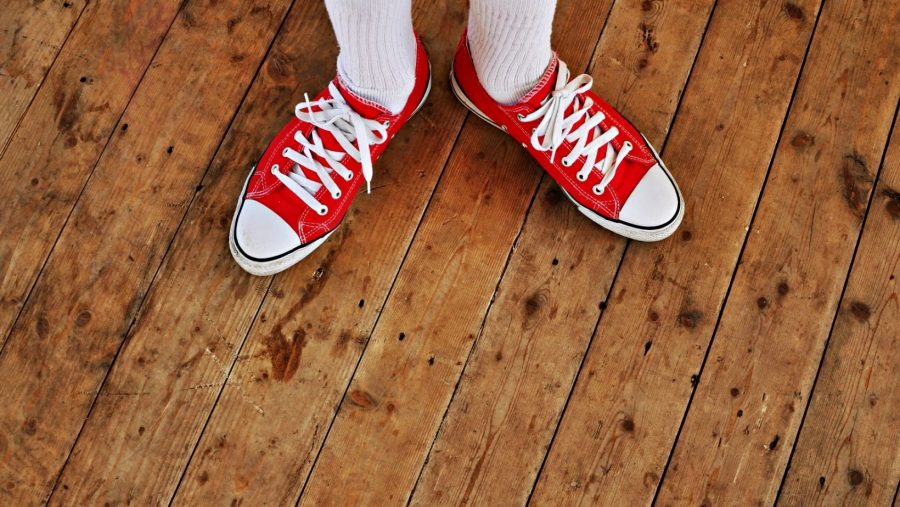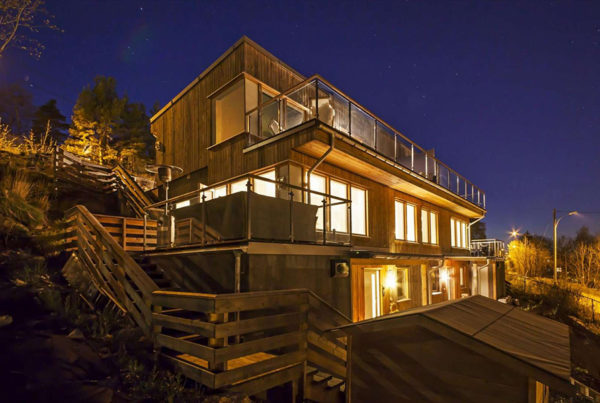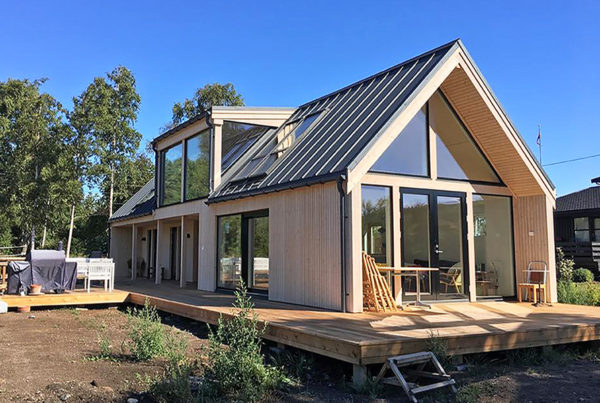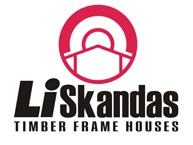A floor or ceiling cassette is a horizontal timber structure of a house that separates different stories of a house. Living floor from the basement, living floor from the attic, or two main stories. It is a composite structure that has to withstand the bending effects of partitions, equipment, occupants, furniture loads, and its own weight acting vertically above it. Floor cassettes are held by loadbearing walls of the lower floor. When spans are too long, extra loadbearing constructions such as beams and columns are added to the design. Correct construction of such floor cassette “binds” the house, adding additional rigidity and stability. Also, insulates sound and heat.
Types of Floor Cassettes
- Floor cassette over the basement – a horizontal structure separating the basement from the timber frame storey above it. This type of floor cassette can be either concrete or wooden. This is a choice of a client based on the project type and the intended use of the basement.
- First storey floor cassette – is only used when the foundation on the house is not a concrete slab, but posts. The sandwich of such floor cassette is mostly the same as the floor between two living floors. However, additional layers for wind-proofing, ventilation and hydro-isolation have to be added from the bottom side.
- Floor cassette between the stories – these count as a floor of the second storey and ceiling of a first. In timber frame house construction this floor is always wooden. This type we will discuss in more detail below.
- Floor cassette between upper storey and attic/loft – the construction that shapes the flat ceiling over the upper floor, also creating a room in the loft. This floor is usually constructed by using horizontal members of attic roof trusses. Due to the lower loads coming from the attic than from the living storey, this floor can be thinner. But in cases where the attic is not usable and the roof insulation is rather transferred to this horizontal construction (leaving attic cold), the floor cassette has to accommodate 30cm of wool insulation.
Wooden floor cassette between the stories
The floor cassette between the stories is the most common type in timber frame houses. This is why we want to talk about it in more detail:
What is the sandwich of floor cassette between the stories?
What is the sandwich of floor cassette between the stories?
Floor cassettes in modular timber frame houses are partly prefabricated elements that mainly consist of the wooden frame and floorboard on top. The rest layers are usually added on-site. The standard sandwich of floor cassette used between two main stories of the timber house are shown in the image below:
Flooring – is the chosen final finish of the floor. The type of flooring can be almost anything the client desires: parquet, laminated floorboards, carpet, tiles, Vinyl, etc. Most of the finishes are laid straight onto the chipboard (with some underlayers if applicable).
Chipboard – for the floor the board we use by default is 22mm thick impregnated chipboard. It is important to lay any flooring board correctly to prevent annoying squeaking sounds. More about it in the FAQ below.
Framework – the floor beam sizes are engineered individually for each project to ensure the floor will not bend. The framework is manufactured using these chosen floor beams and placed in calculated distances to form a stable and rigid construction. More about the sizes below.
Insulation – this type of floor as discussed previously is laid between two internal areas of the house, thus insulation would be not necessary. However, if we don‘t add any of the insulation in the frame the echoes will be loud when someone is walking on the upper story. In this case, the insulation is mostly used to insulate the sound and not the heat/cold. A minimum of 100mm is recommended to be used on the floor between the stories, but for better soundproofing, the whole frame can be filled with it. Insulation is loaded to the frame after the floor cassette is assembled on-site.
Lathing (or battens) – wooden square battens, usually 45x45mm in size, placed on-site perpendicularly to and under the insulated floor beams. The lathing is used for placing lighting items and electrical wiring. These battens can be increased in size on request. For example, LED lighting items are higher than 45mm, and 45x75mm lathing is then used. Battens are always installed on-site, however, their sizing must be decided prior to production of the house modules.
Inside Facing – gypsum boards are one of the standard finishes in modern living houses, however, the internal-facing can also be tiled, wooden T&G panel, MDF boards, you name it. If the chosen finish is gypsum, the lathing (mentioned above) has to be fixed at c/c400mm to prevent board bending. Inside facing is fixed on-site.
Fire-proof and acoustic ceiling cassette
In Norway and Sweden building detached houses it is common to use fire-proof, acoustic ceilings. Additional layers are required for such construction. The sandwich of specialty ceilings and floors has to be designed by a local engineer, specialist and we can manufacture accordingly. However, one of the types we already did was adding floating plasterboard and 2cm hard insulation between the final finish and chipboard. From the bottom site, the lathing had to be suspended on special metal holders and an additional layer of plasterboard (2 in total) added to the ceiling face.
What size floor beams are used in floor cassettes?
In the production of our floor cassettes, we use certified C24 wooden beams. The cross-section and length are calculated on engineering software for each project at the design stage of the project. For smaller spans beams 45×220 and 45×240 are used. If these are too weak, they can be doubled. Other design options can be choosing the 70mm width instead of 45 mm, minimizing the distance between the beams, or changing standard wooden beams to I-beams. For the biggest distances additional glue-lam beams, metal H profile beams, and columns are used.
In the table below you can see some of the common sizings of such beams under the specific load conditions and using C24 wood. All the values are recommended to be recalculated by your architect specifically for your project‘s load conditions. Because adding some more furniture or a heating floor system will affect the sizes of wood to be chosen.

What are Frequently Asked Questions about floor cassettes?
Is it possible to lay concrete on the wooden floor cassette?
Yes, usually the 50mm layer of concrete is used for heated floor systems. The weight of the concrete layer must be considered in the calculations for cross-sections and lengths of floor beams. Therefore, when our clients are in the technical design phase of each project, the question about additional floor layers is one of many we ask. While we do not install heated floor systems ourselves, the layers above our floor cassette sandwich are important because they may affect connections to the walls, length of wall layers, internal house heights, etc.
Does wool insulation need to be installed in the floor cassette between two floors (inside spaces)?
It is up to the client. It is not compulsory, but we recommend having at least 100mm. The reason is not thermal insulation, but sound. Leaving an empty floor cassette will create an echo effect when someone is walking on the second floor.
I know a wooden floor is not vibration resistant. Also, squeaks – how to avoid it.
Yes, the squeaking floor is one of the timber frame myths. We could call it a problem of old-tech wooden houses. To date, this problem is solved using improved technology and principles. When a person walks on the floor, it causes the floor to vibrate, to “jump”. At that moment, the floorboard bends, and its edges raise a little, causing friction between the nails and the board, and the annoying sound. To prevent this, 55mm screws are used (instead of nails), which do not allow the edges of the floor to move. (Special twisted or notched nails can be used as well.) For extra grip, glue the board to the floor beams. Few other installation tips: the gap between floor beams shall not be bigger than 600mm (to minimize bending); there has to be a 3mm gap between the floorboards; and a 6-12mm gap from the board edge to the wall. It is important to keep the chipboard inside the room temperature for at least 24 hours before mounting.






